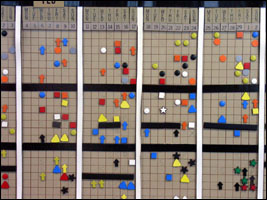 It starts as a blank canvas, nearly six feet long and four feet high. It spans time and space, accounting for 187 days and hundreds of thousands of miles. And it will soon become the road map for 29 teams’ journey to the Calder Cup.
It starts as a blank canvas, nearly six feet long and four feet high. It spans time and space, accounting for 187 days and hundreds of thousands of miles. And it will soon become the road map for 29 teams’ journey to the Calder Cup.
Goals are scored and games are won on sheets of ice across North America, but the centerpiece of the AHL’s hockey operations department is actually a giant magnetic schedule board hanging on a wall in downtown Springfield, Mass.
The making of the 2008-09 AHL schedule is a process that actually began six months ago, and will culminate when the final product is released to the public, likely during the first week in August.
The AHL’s constitution calls for each member club to submit to the league, in February of the previous season, a list of primary and secondary dates on which it will be available to play at home. Teams also provide blackout dates, when they cannot play at home because of other events in their arena.
Around the end of the Calder Cup Playoffs, the AHL will confirm for each team a list of six guaranteed dates for the upcoming season. This allows clubs to begin making preparations and drumming up interest in the coming year. Many teams have already announced their guaranteed dates, some including their home openers, for 2008-09.
Once a format (who plays whom, and how often) is designed and approved by the Board of Governors at their Annual Meeting in late June, the schedule can truly begin to take shape.
Jim Mill, the AHL’s executive vice president of hockey operations, is the keeper of the schedule board, which adorns almost one full wall opposite the desk in his office. Creating the schedule is a tedious manual process, not unlike putting together a giant jigsaw puzzle without a picture on the box to work from.
The league’s teams are identified on the big board by magnets of different shapes and colors: Providence is a black circle. Wilkes-Barre/Scranton is a blue square. Chicago, a yellow star. Each team also gets a cup filled with 40 magnets, one for each of its home opponents as prescribed by the schedule format.
The teams are lined up on the board top to bottom by division, with dates stretching left to right. What results is essentially a 187-by-29 framework, creating 5,423 blank spaces in which to fill a total of 1,160 games.
From there, Mill and his staff work – sometimes for 12 or more hours a day – to fill in the holes on the board.
Care must always be given to logistics and travel considerations. You obviously can’t have a team at home and on the road on the same night. You can’t have a team scheduled for games on four successive nights. Trips to Texas, the Midwest or New England usually call for multiple games in one stretch, especially for out-of-conference visitors. And you want to avoid unwieldy travel situations, especially when winter weather will undoubtedly become a factor.
The last pieces of the puzzle cannot be put in place until late July, when the NBA finalizes its own schedule. That’s because the Houston Aeros, Milwaukee Admirals, San Antonio Rampage and Lake Erie Monsters all share arenas with NBA teams who get first dibs at building dates.
The phones ring steadily, with presidents and general managers from all 29 AHL teams hoping to ensure that their own schedule is ideal. But while there’s no pleasing everybody, procedures are in place to resolve as many issues as possible.
Once all the magnets are in position, the board is transcribed into a computerized spreadsheet – creating one master schedule and 29 individual team schedules – and the proofreading begins. Each club receives a copy of the first draft, and may request changes with the mutual consent of all other teams involved, either swapping opponents on two or more dates or moving dates altogether.
After requested changes are approved by the AHL and incorporated into the schedule, a second draft is created and teams have one last opportunity to request tweaks.
The final set of changes is OK’d by the league, and the master schedule is ready for release. Teams are notified, everyone’s announcements are coordinated, and with the click of the “send” button, e-mails and faxes are fired off and the schedule is available to the public.
Before long, training camps open, the puck drops, and the whole process starts all over again.
The making of the AHL schedule is a grueling and thankless job, but it’s safe to say the American Hockey League wouldn’t function without it.
This story first appeared on theahl.com in July 2004.

































